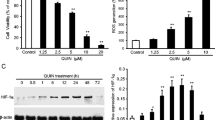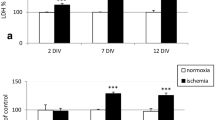Abstract
To assess RNAi mediated inhibition of the expression of wt-DYT1 on H2O2-induced toxicity in NIH 3T3 cells and primary cortical neurons. To detect the function of wild-type Torsin A and the effect of SiRNA on the wt-DYT1 gene. The shRNA expression vector was constructed by ligating annealed complementary shRNA oligonucleotides into the down-stream of the human U6 promoter (PU6) of the RNAi-ready pSIREN-Shuttle vector. Then, the pSIREN-Shuttle-DYT1-shRNA cassette was ligated to Adeno-X Viral DNA to construct the recombinant adenoviral vector pAd-DYT1-shRNA. Cultured cerebral cortical neurons and NIH 3T3 cells were transfected with pAd-DYT1-shRNA and pSIREN-Shuttle-DYT1-shRNA. We evaluated NIH 3T3 cells and neurons in the presence of oxidative stress using a TUNEL assay under different conditions. The knockdown efficacy of the DYT1 was confirmed by real-time RT-PCR and Western Blot analysis. After exposure to H2O2, the quantity of NIH 3T3 cells transfected with pSIREN-Shuttle-DYT1-shRNA, which stained positively in the TUNEL assay, was significantly higher than the cells transfected with pSIREN-Shuttle-negative control-shRNA. (44.85 ± 1.81% vs. 8.98 ± 2.73%, t = 26.168). There were significantly more apoptotic neurons infected with pAd-DYT1-shRNA (45.63 ± 7.53%) than neurons infected with pAd-X-negative control-shRNA (17.33 ± 2.43%) (t = 9.816). The observed silencing of wild-type Torsin A expression by DYT1-shRNA was sequence-specific. RNAi-mediated inhibition of the expression of wild-type Torsin A increases apoptosis caused by oxidative stress. It is reasonable to consider that wild-type Torsin A has the capacity to protect cortical neurons against oxidative stress, and in the development of DYT1-delta GAG-dystonia the neuroprotective function of wild-type Torsin A may be compromised.






Similar content being viewed by others
Abbreviations
- DYT1:
-
Dystonia type 1
- DA:
-
Dopamine
- ER:
-
Endoplasmic reticulum
- KLC1:
-
Light chain subunit of kinesin-I
- hWT:
-
human wild-type Torsin A
- hMT:
-
human mutant Torsin A
- LAP1:
-
Lamina-associated polypeptide 1
- MPTP:
-
1-methyl-4-phenyl-1, 2, 3, 6-tetrahydropyridine
- NE:
-
Nuclear envelope
- RNAi:
-
RNA interference
- shRNA:
-
small double-stranded hair RNA
- siRNA:
-
small double-stranded interfering RNA
- TUNEL:
-
Terminal deoxynucleotidyl transferase-mediated dUTP nick-end-labeling
References
Bressman SB (2007) Genetics of dystonia: an overview. Parkinsonism Relat Disord 13(Suppl 3):347–355
Geyer HL, Bressman SB (2006) The diagnosis of dystonia. Lancet Neurol 5:780–790
Albanese A (2007) Dystonia: clinical approach. Parkinsonism Relat Disord 13(Suppl 1):3356–3361
Schwarz CS, Bressman SB (2009) Genetics and treatment of dystonia. Neurol Clin 27:697–718
Shanker V, Bressman SB (2009) What’s new in dystonia? Curr Neurol Neurosci Rep 9:278–284
Bressman SB et al (1997) Secondary dystonia and the DYTI gene. Neurology 48:1571–1577
Leung JC et al (2001) Novel mutation in the TOR1A (DYT1) gene in atypical early onset dystonia and polymorphisms in dystonia and early onset Parkinsonism. Neurogenetics 3:133–143
Asmus F et al (2007) Genomic deletion size at the epsilon-sarcoglycan locus determines the clinical phenotype. Brain 130:2736–2745
Breakefield XO et al (2001) TorsinA: movement at many levels. Neuron 31:9–12
Beuron F, Dreveny I, Yuan X, Pye VE, Mckeown C, Briggs LC, Cliff MJ, Kaneko Y, Wallis R, Isaacson RL, Ladbury JE, Matthews SJ, Kondo H, Zhang X, Freemont PS (2006) Conformational changes in the AAA ATPase adaptor complex. EMBO J 25:1967–1976
Ferrari-Toninelli G et al (2004) TorsinA negatively controls neurite outgrowth of SH-SY5Y human neuronal cell line. Brain Res 1012:75–81
Kamm C et al (2004) The early onset dystonia protein torsinA interacts with kinesin light chain 1. J Biol Chem 279:19882–19892
Hewett JW et al (2006) Dystonia-causing mutant torsinA inhibits cell adhesion and neurite extension through interference with cytoskeletal dynamics. Neurobiol Dis 22:98–111
Bragg DC et al (2004) Inhibition of N-linked glycosylation prevents inclusion formation by the dystonia-related mutant form of torsinA. Mol Cell Neurosci 27:417–426
Torres GE et al (2004) Effect of torsinA on membrane proteins reveals a loss of function and a dominant-negative phenotype of the dystonia-associated DeltaE-torsinA mutant. Proc Natl Acad Sci USA 101:15650–15655
Augood SJ, Keller-McGandy CE, Siriani A, Hewett J, Ramesh V, Sapp E, DiFiglia M, Breakefield XO, Standaert DG (2003) Distribution and ultrastructural localization of torsinA immunoreactivity in the human brain. Brain Res 986:12–21
Kuner R et al (2004) TorsinA, the gene linked to early-onset dystonia, is upregulated by the dopaminergic toxin MPTP in mice. Neurosci Lett 355:126–130
Zhao Y, DeCuypere M, LeDoux MS (2008) Abnormal motor function and dopamine neurotransmission in DYT1 ΔGAG transgenic mice. Exp Neurol 210:719–730
Martin JN et al (2009) Transcriptional and proteomic profiling in a cellular model of DYT1 dystonia. Neuroscience 164:563–572
Granata A, Watson R, Collinson LM, Schiavo G, Warner TT (2008) The dystonia-associated protein torsinA modulates synaptic vesicle recycling. J Biol Chem 3:7568–7579
Dang MT, Yokoi F, McNaught KSP et al (2005) Generation and characterization of Dyt1 DGAG knock-in mouse as a model for early-onset dystonia. Exp Neurol 196:452–463
Dang MT, Yokoi F, Pence MA, Li Y (2006) Motor deficits and hyperactivity in Dyt1 knockdown mice. Neurosci Res 56:470–474
Grundmann K et al (2007) Overexpression of human wildtype torsinA and human DeltaGAG torsinA in a transgenic mouse model causes phenotypic abnormalities. Neurobiol Dis 27:190–206
Wichmann T (2008) Commentary: dopaminergic dysfunction in DYT1 dystonia. Exp Neurol 212:242–246
Goodchild RE, Kim CE, Dauer WT (2005) Loss of the dystonia-associated protein torsinA selectively disrupts the neuronal nuclear envelope. Neuron 48:923–932
Kuner R et al (2003) TorsinA protects against oxidative stress in COS-1 and PC12 cells. Neurosci Lett 350:153–156
Torres GE, Sweeney AL, Beaulieu JM, Shashidharan P, Caron MG (2004) Effect of torsinA on membrane proteins reveals a loss of function and a dominant-negative phenotype of the dystonia-associated ΔE-torsinA mutant. PNAS 101:15650–15655
Cao S, Gelwix CC, Caldwell KA, Caldwell. GA (2005) Torsin-mediated protection from cellular stress in the dopaminergic neurons of Caenorhabditis elegans. J Neurosci 25:3801–3812
Gonzalez-Alegre P (2007) The inherited dystonias. Semin Neurol 27:151–158
Hewett J et al (2000) Mutant torsinA, responsible for early-onset torsion dystonia, forms membrane inclusions in cultured neural cells. Hum Mol Genet 9:1403–1413
Walker RH et al (2001) Distribution and immunohistochemical characterization of torsinA immunoreactivity in rat brain. Brain Res 900:348–354
Konakova M, Pulst SM (2001) Immunocytochemical characterization of torsin proteins in mouse brain. Brain Res 922:1–8
Hewett JW et al (2004) TorsinB-perinuclear location and association with torsinA. J Neurochem 89:1186–1194
Hannon GJ (2002) RNA interference. Nat Genet 418:244–251
Miller VM, Paulson HL, Gonzalez-Alegre P (2005) RNA interference in neuroscience: progress and challenges. Cell Mol Neurobiol 25:1195–1207
Rossi JJ, Castanotto D (2009) The promises and pitfalls of RNA-interference-based therapeutics. Nat Genet 457:426–433
Rij RPv (2008) Virus meets RNAi: symposium on antiviral applications of RNA interference. EMBO reports 9:725–729
Haasnoot J, Westerhout EM, Berkhout B (2007) RNA interference against viruses: strike and counterstrike. Nat Biotechnol 25:1435–1443
Gonzalez-Alegre P, Miller VM, Davidson BL, Paulson HL (2003) Toward therapy for DYT1 dystonia: allele-specific silencing of mutant torsinA. Ann Neurol 53:781–787
Kock N, Allchorne AJ, Sena-Esteves M, Woolf CJ, Breakefield XO (2006) RNAi blocks DYT1 mutant torsinA inclusions in neurons. Neurosci Lett 395:201–205
Harper SQ, Gonzalez-Alegre P (2008) Lentivirus-mediated RNA interference in mammalian neurons. Methods Mol Biol 442:95–112
Hewett JW et al (2008) siRNA knock-down of mutant torsinA restores processing through secretory pathway in DYT1 dystonia cells. Hum Mol Genet 17:1436–1445
de Carvalho Aguiar PM, Ozelius LJ (2002) Classification and genetics of dystonia. Lancet Neurol 1:316–325
Ozelius LJ et al (1998) The gene (DYT1) for early-onset torsion dystonia encodes a novel protein related to the Clp protease/heat shock family. Adv Neurol 78:93–105
Ozelius LJ et al (1999) The TOR1A (DYT1) gene family and its role in early onset torsion dystonia. Genomics 62:377–384
Hewett J et al (2003) TorsinA in PC12 cells: localization in the endoplasmic reticulum and response to stress. J Neurosci Res 72:158–168
Cao S et al (2005) Torsin-mediated protection from cellular stress in the dopaminergic neurons of Caenorhabditis elegans. J Neurosci 25:3801–3812
Yokoi F et al (2008) Motor deficits and hyperactivity in cerebral cortex-specific Dyt1 conditional knockout mice. J Biochem 143:39–47
Rostasy K et al (2003) TorsinA protein and neuropathology in early onset generalized dystonia with GAG deletion. Neurobiol Dis 12:11–24
Granata A et al (2009) TorsinA and dystonia: from nuclear envelope to synapse. J Neurochem 109:1596–1609
Gonzalez-alegre P, Gordon KL (2008) Consequences of the DYT1 mutation on torsinA oligomerization and degradation. Neuroscience 157:588–595
Henriksen C et al (2009) Characterization of the porcine TOR1A gene: the first step towards generation of a pig model for dystonia. Gene 430:105–115
Goodchild RE, Dauer WT (2005) The AAA+protein torsinA interacts with a conserved domain present in LAP1 and a novel ER protein. J Cell Biol 168:855–862
Bahn E et al (2006) TorsinB expression in the developing human brain. Brain Res 1116:112–119
Acknowledgments
This study was supported by the National Science Fund of China (No. 30400144).
Author information
Authors and Affiliations
Corresponding author
Rights and permissions
About this article
Cite this article
Chen, XP., Hu, XH., Wu, SH. et al. RNA Interference-Mediated Inhibition of Wild-Type Torsin A Expression Increases Apoptosis Caused by Oxidative Stress in Cultured Cells. Neurochem Res 35, 1214–1223 (2010). https://doi.org/10.1007/s11064-010-0177-4
Accepted:
Published:
Issue Date:
DOI: https://doi.org/10.1007/s11064-010-0177-4




